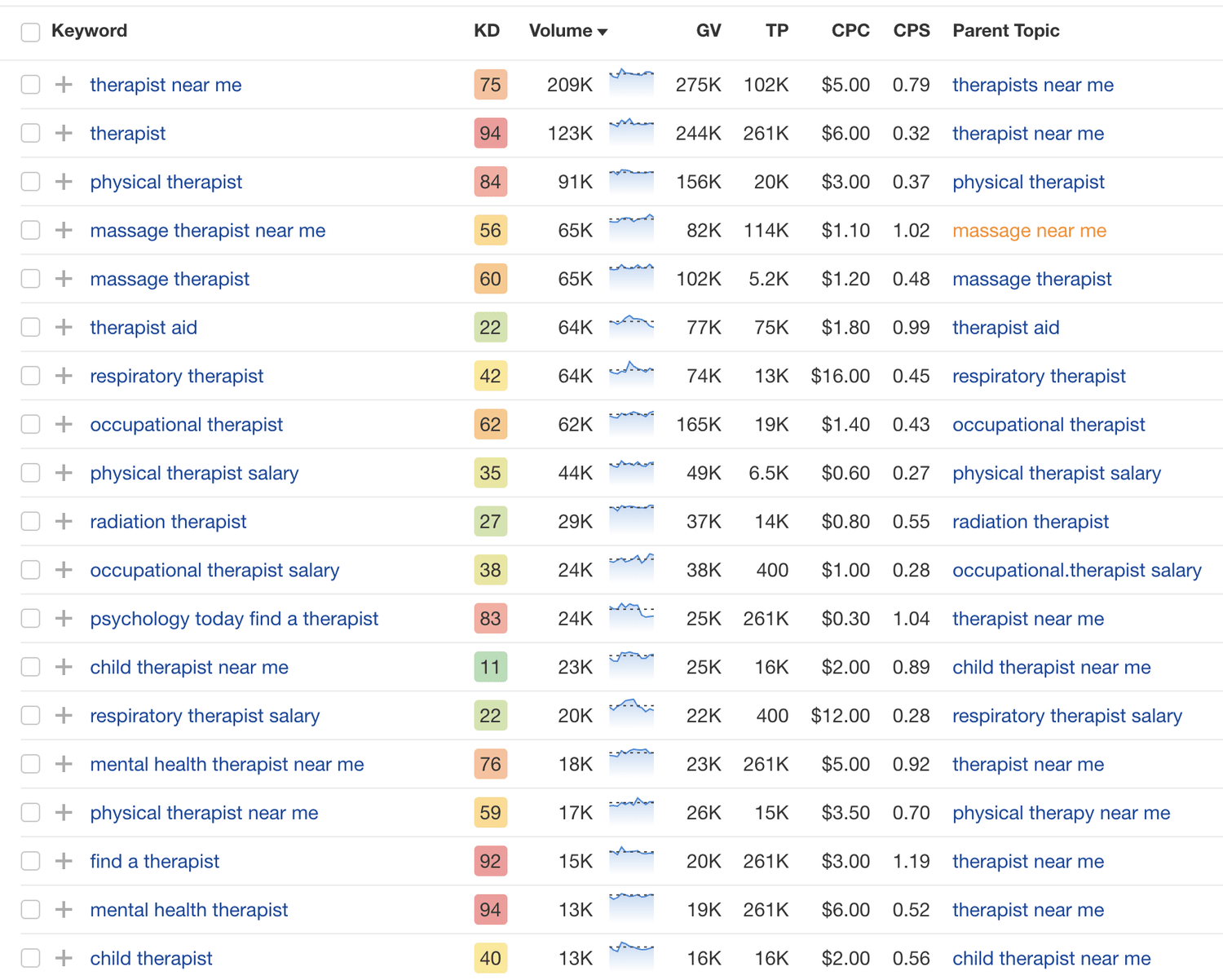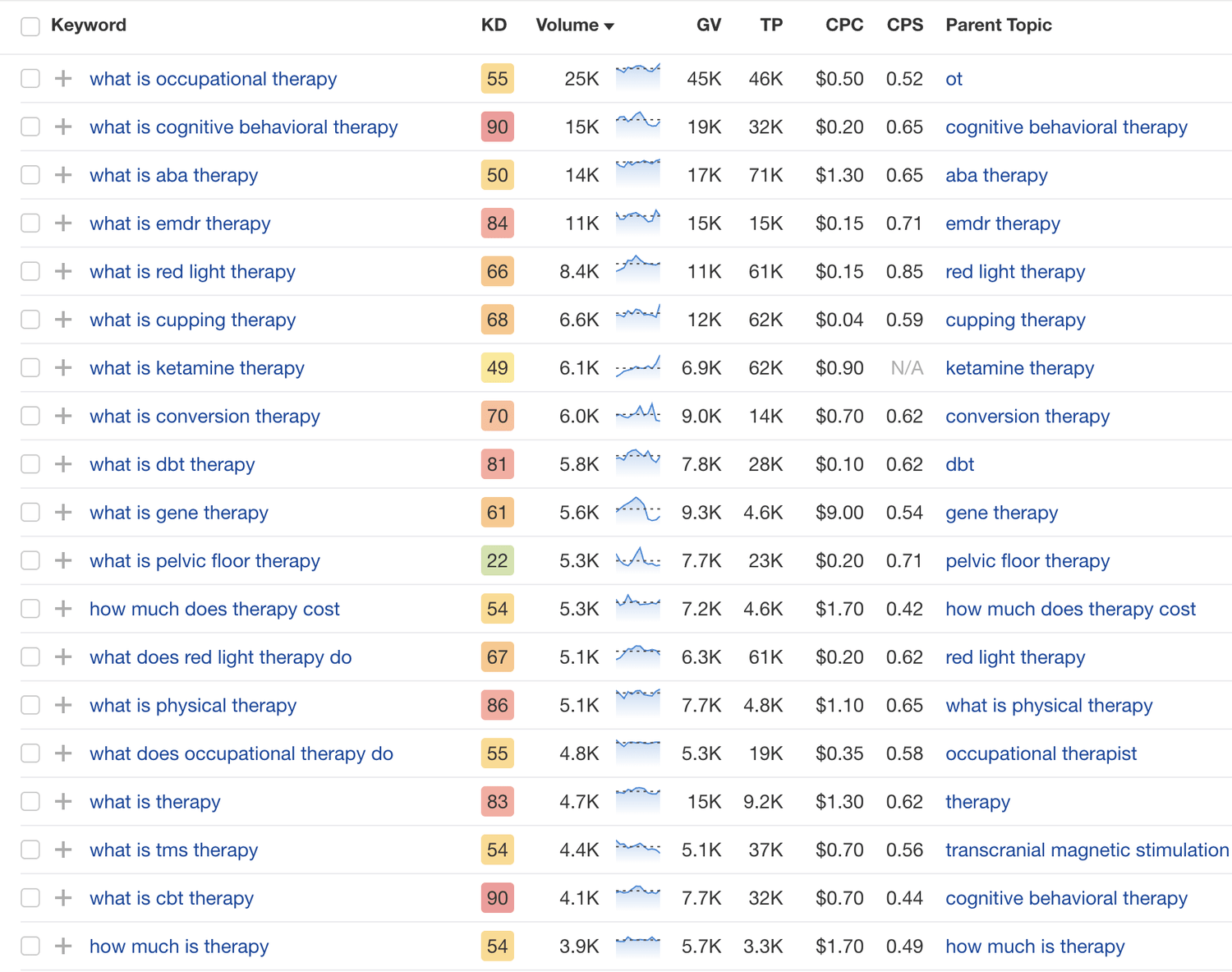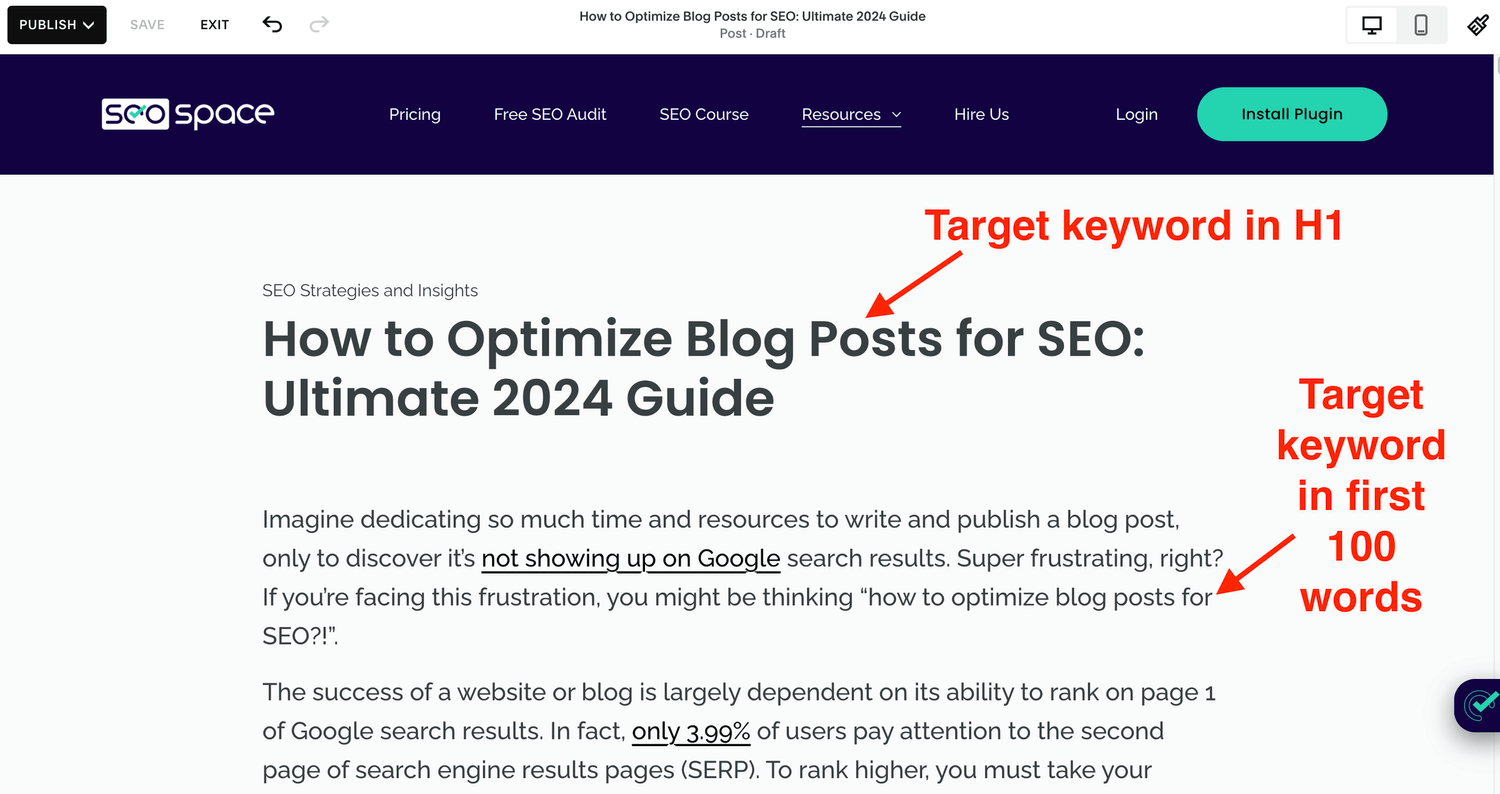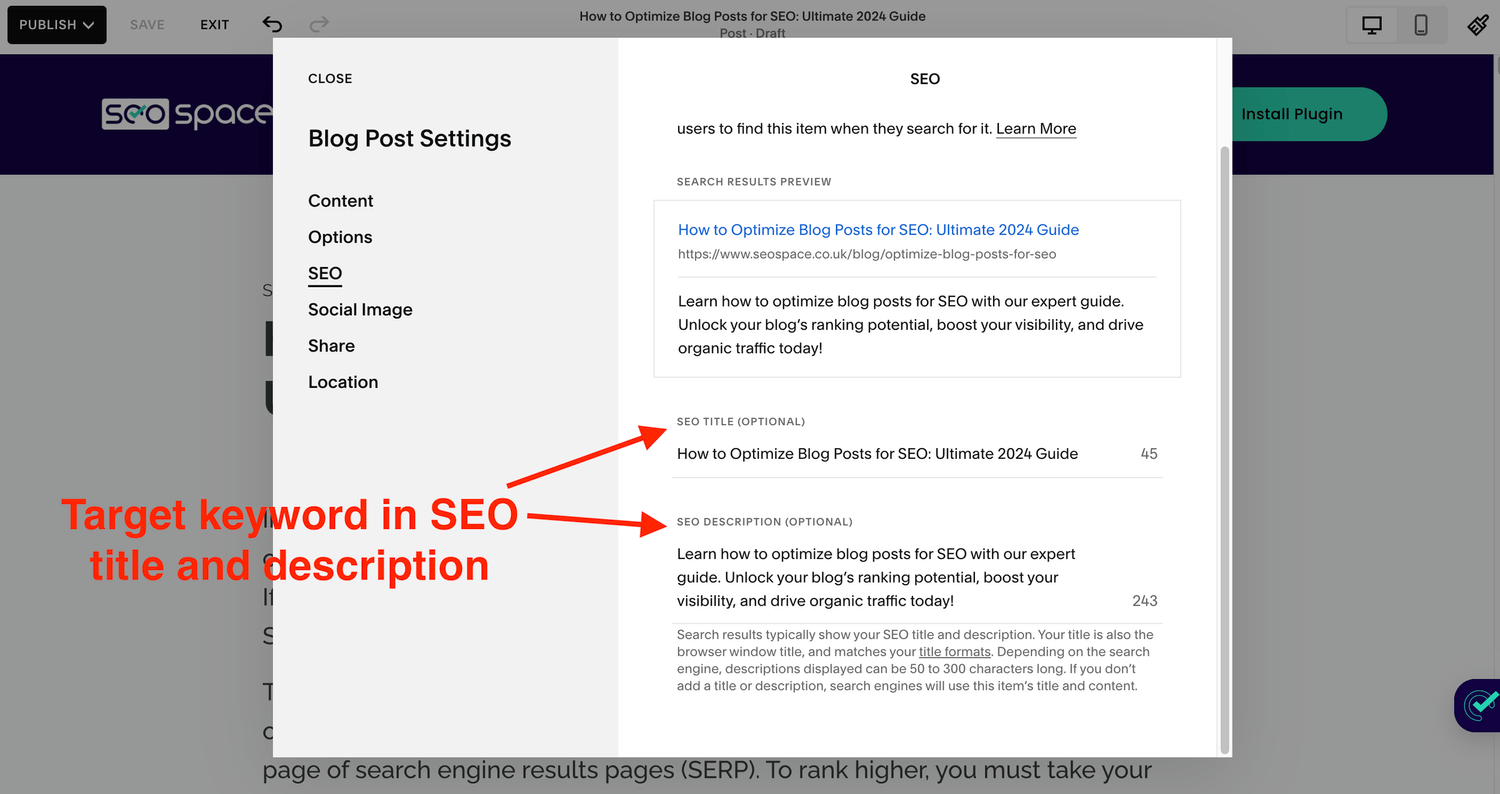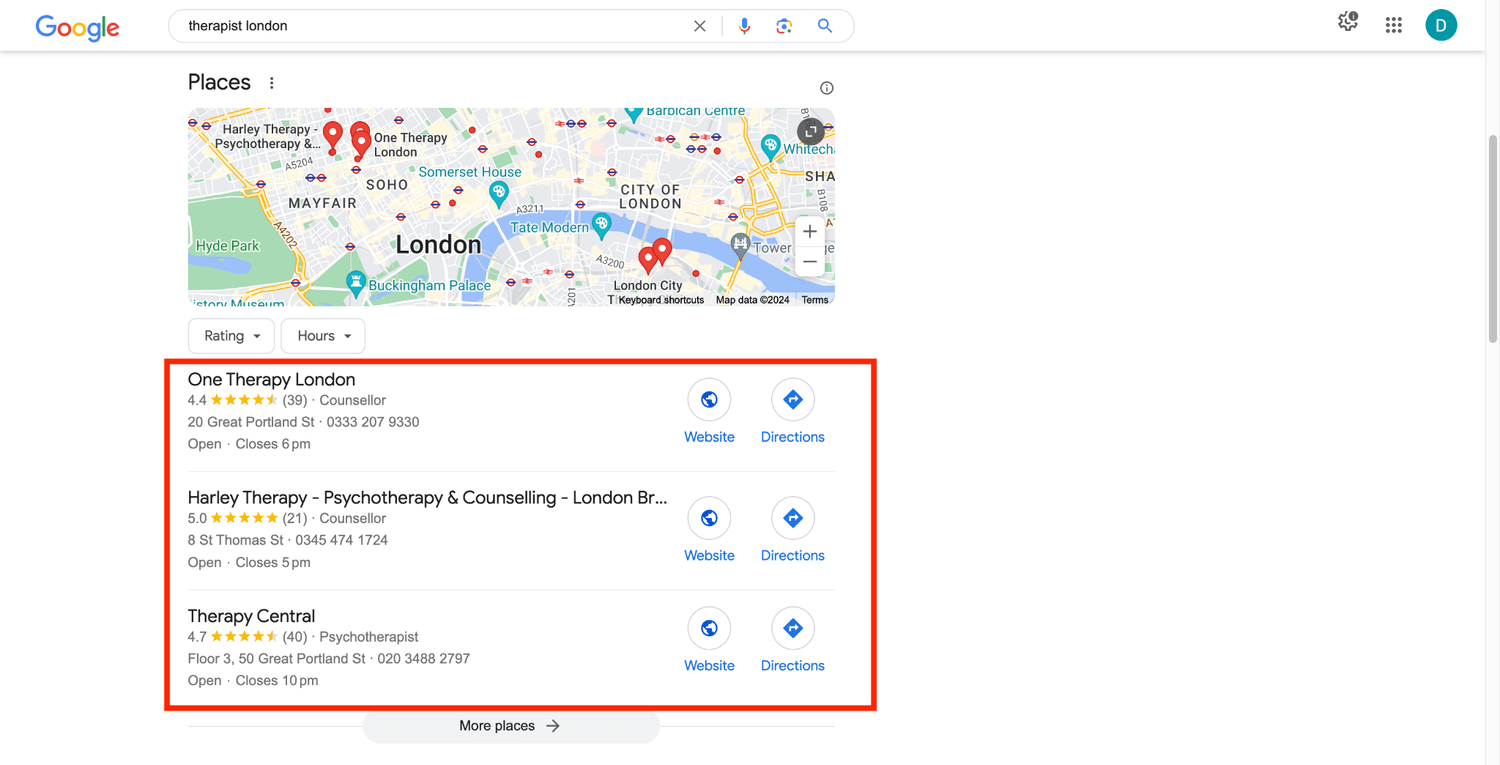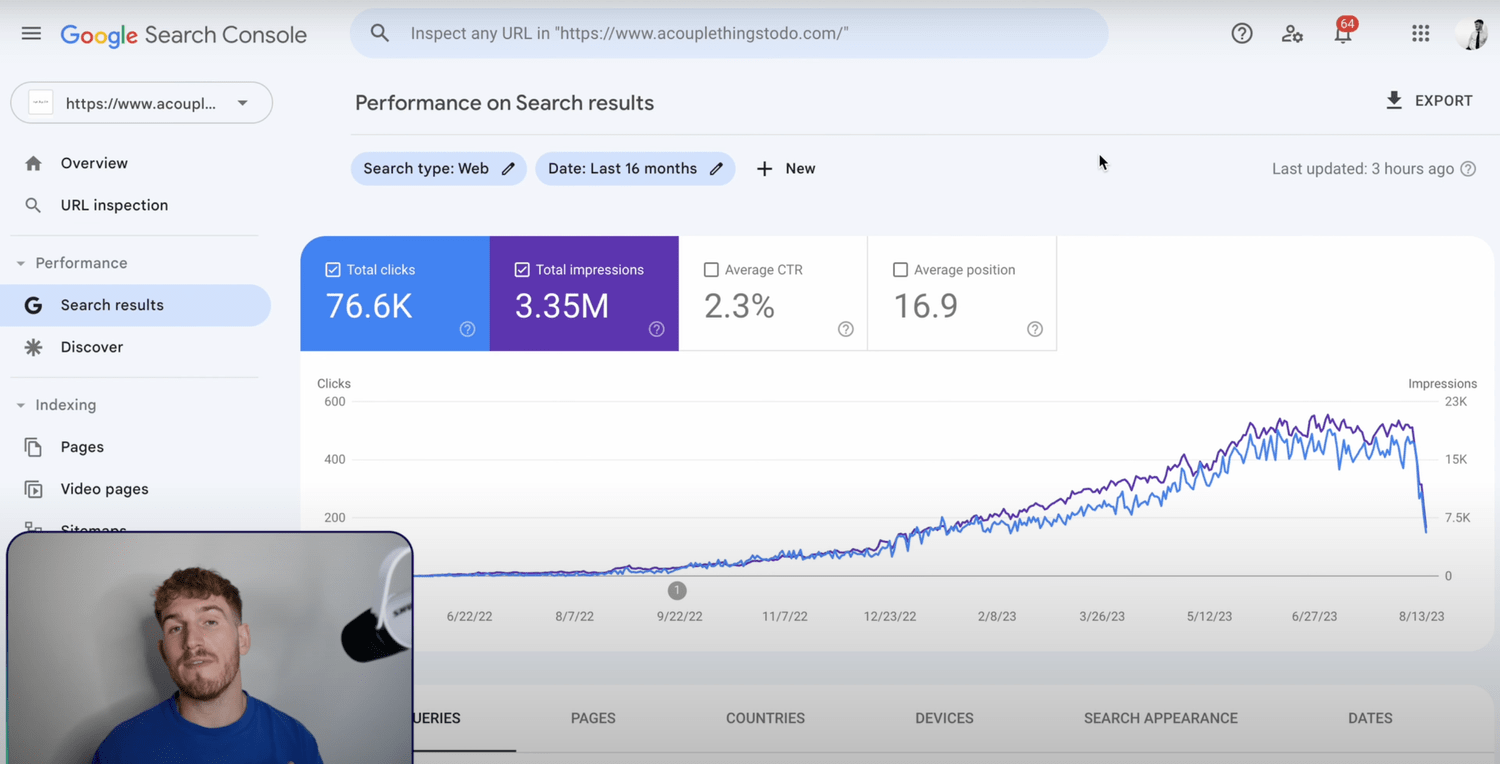SEO for Therapists: A 9-Step Guide to Ranking #1 on Google
Have you explored different avenues to secure leads for your therapy/counseling business, all to no avail? Perhaps your referral network used to be your go-to channel for new clients, but it’s not been yielding tangible results in recent times.
As a therapist trying to grow your online practice in this digital age, one important area to focus on is search engine optimization (SEO). This is how you can promote your therapy/counseling services online and generate inbound leads from people searching for your services on Google.
But where do you start? What should you focus on when doing SEO for therapists?
Given our years of experience providing SEO services to clients, we understand the struggle you’re facing. In fact, at SEOSpace, we’ve been able to help thousands of businesses rank high on Google and drive more leads from organic traffic via our Squarespace SEO plugin.
We’ve condensed our broad knowledge of the SEO field and the therapist industry to put together this ultimate guide. By implementing the steps in this guide, you can send your website views soaring again.
SEO for Therapists Guide Contents
9-Step Guide for Therapist SEO Summary
Step 1. Conduct in-depth keyword research.
Step 2. Do a comprehensive competitor analysis.
Step 3. Adopt on-page SEO best practices.
Step 4. Set up and optimize your Google My Business profile.
Step 5. Develop compelling and valuable content.
Step 6. Connect Google Search Console and Google Analytics.
Step 7. Build backlinks and citations.
Step 8. Optimize user experience to improve your conversion rate.
What Is SEO for Therapists?
Simply put, SEO (search engine optimization) for therapists is the process of optimizing your website so that it ranks higher on Google for terms your target customers search. As a therapist, it’s not enough to have an online presence; you must also look professional and make it easy for potential clients to find you. This is where SEO plays a crucial role — it enhances your visibility, bringing your services to the forefront when someone searches for therapy or mental health services online.
Why Is It Important?
In today’s digital age, most people turn to search engines like Google when they’re looking for therapy services. If your website doesn’t appear on the first page of Google search results, you’re virtually invisible to potential clients. In fact, only 0.44% of users check out Google’s second page!
Good SEO practices, including 'SEO for therapists,' ensure your website isn't lost in the digital abyss. Instead, they position your therapy/counseling services right where they need to be: in front of potential clients actively searching for the help you offer.
How Can SEOSpace Help?
SEOSpace not only has the SEO plugin for Squarespace, but we also have leading SEO services. Book a discovery call today to discuss your SEO project needs!
9-Step Guide for Therapist SEO Summary
Before we get into the details below, we’ve included a summary so therapists can have a successful SEO campaign and get their target audience to their website without paying crazy amounts for SEO tools.
Keyword Research and SEO Strategies for Mental Health Professionals: Begin with a comprehensive keyword research process to identify keywords and perform keyword research that targets potential clients looking for mental health services. This foundational step is essential for mental health professionals to optimize their private practice website and boost their SEO efforts.
Technical SEO Enhancements: Focus on technical SEO to ensure that search engines recognize and favor the website. Optimize technical aspects such as meta descriptions and overall site structure, ensuring that technical SEO is applied effectively to meet the algorithms of search engines and appear on the search engine results page.
Local SEO and Link Building: Strengthen local SEO and link building to enhance visibility in search results. Optimize your Google My Business profile and engage in link building to improve local search rankings and attract more clients to your counseling services.
Content Development for Targeting Relevant Keywords: Develop content that specifically addresses the needs of other mental health professionals and potential clients, integrating relevant keywords strategically. This content should also cater to those seeking counseling services, thus improving engagement and relevance in search results - the easiest way to do this is by optimizing blog posts for SEO.
Off-Page SEO and Continuous Improvement: Implement off-page SEO techniques and regularly update your SEO strategies to maintain competitiveness in the digital landscape and speed up SEO. This includes fostering backlinks and updating content to keep pace with SEO best practices and the changing dynamics of providing mental health services online.
Step 1. Conduct in-depth keyword research.
Keyword research is the crucial first step in any strategy aimed at optimizing SEO for therapy businesses.
Note: Keywords are the various words or phrases that clients type into Google and other search engines when seeking therapist services online.
As a therapist, you need to identify the specific keywords and phrases that potential clients are using when searching for your services online. This ensures your website pages are optimized to rank for those high-value search queries.
Start by making a list of the core services you offer, such as marriage counselling, addiction therapy, child psychology, etc. For each service, use a keyword research tool like Google’s Keyword Planner, SEMrush, or Keyword Everywhere to see search intent and find relevant keyword ideas. Look for lower keyword difficulty scores to gauge competition and high search volume data to identify viable focus keywords.
Some good SEO keywords to target might include:
Therapist near me
CBT for anxiety
Find a therapist
Child therapist near me
Expand your list by including keyword variations and long-tail key phrases, too, like “what is cognitive behavioral therapy” or “local childhood trauma counseling in [CITY NAME].” The more niche and targeted your keywords are to your specialties, the better your chances of ranking for them, as they usually have lesser competition.
Now, refine that big list down to your top 10–20 most relevant focus keywords, i.e., the specific terms you want individual website pages to rank for. This is crucial for on-page optimization, which we’ll discuss later.
Additionally, it’s important to address common questions related to your services when curating website content. You can identify these FAQs when doing keyword research. When you provide answers to these questions, Google can display your website’s content in the featured snippets section of the search results, increasing your website’s visibility, and increasing your chances of securing inbound leads.
For example, you can answer questions like:
What is occupational therapy
What is conversion therapy
How much does therapy cost
Conduct research on keywords regularly to stay on top of the latest trends. Also, adapt your approach if certain keywords decline in popularity or you expand your services. Remember, comprehensive keyword data lays the foundation for SEO success.
Step 2. Do a comprehensive competitor analysis.
This is a critical step that so many therapists skip over or just glance at despite the several insights it offers.
Doing a deep dive into competitors offers tremendous insight into:
What keywords and topics your competitors are ranking for
How they are optimizing their sites
Gaps where you can outrank them
Let’s break down the competitor analysis process into bite-sized steps:
Find relevant competitors.
Use Google searches, reviews sites like Yelp, and any therapist directories out there to make a list of therapists in your city or region that offer similar services to you.
Analyze their websites.
If a competitor is ranking on page 1, it means they’re doing something right in terms of SEO. As discussed in our webinar on how to outrank the competition, you need to study their on-page content, site architecture, titles, and headers. See what therapist or counseling keywords they are targeting and how they incorporate them naturally. Make notes on what they do well… and perhaps not so well.
Check their rankings.
See where they rank in Google for various related keywords. This helps you identify opportunities to potentially outrank them by creating better content focused on the right search terms.
Replicate their best ideas.
Imitation is the best form of flattery — no need to reinvent the wheel. If a competitor does something exceptionally well that aligns with your brand, borrow some of their best practices. Then, put a unique spin on it. For example, you could gather therapy/counseling blog post ideas from competitors. By publishing similar insightful content that addresses client pain points, you establish yourself as an expert in the therapy industry, increasing your chances of ranking high on search engines.
SEO for therapy websites isn’t complete without proper competitor research. This gives you an invaluable blueprint of what you need to do to rank well on Google for your specific niche. Use these insights to shape your overall SEO strategy and content plan. It makes the entire process much more focused and effective.
Step 3. Adopt on-page SEO best practices.
On-page SEO is the process of making sure your web pages adhere to SEO best practices to increase visibility on search engines.
These best practices include optimizing the following elements of your website:
Keywords: Include your target keywords naturally in strategic places like page titles, meta descriptions, headings, image alt text, and as much as naturally possible in the body content. Don’t over-optimize by forcing keywords into areas where they don’t fit or sound right. This is known as keyword stuffing and can get your website penalized by Google.
Page Titles: Keep page titles between 50 and 60 characters, including your main keyword early on. This is critical for search visibility.
Meta Descriptions: We recommend limiting your pages’ meta descriptions to 150–160 characters and incorporating your primary keyword into them. These help users understand what your individual pages are about when your website shows up on Google SERPs.
Headings: Break up content with relevant H2 and H3 headings containing keywords to aid readability and make it easier for search engines to understand your content. Don’t just use block headings.
Media: Optimize images with descriptive alt text and file names containing keywords. If you have a therapy video on your website, add transcripts to it.
Links: Link out to authority sites and internal pages with anchor text keywords.
Schema Markup: Add schema markup to data on your webpage. This can be therapy services, products, articles, etc. Schema markup helps search bots understand your content better, and optimizing them can help increase your rankings on search engines.
Sticking to the above best practices is essential for optimizing your therapy website for SEO. If you use Squarespace, our SEO plugin is a great tool for performing site-wide audits that help detect pages with unoptimized on-page SEO elements. You may also check out our Squarespace SEO checklist for more information.
Tip: If you’re just getting started setting up your website, a good way to ensure your on-page SEO elements are optimized is to opt for the best SEO Squarespace templates for therapists. These templates come pre-packed with SEO prompts that guide you towards creating a website that not only offers stellar user experience but also ranks high on search engines, helping you reach your target market.
Step 4. Set up and optimize your Google My Business profile.
Google My Business is the core of local SEO for service businesses. Setting up and optimizing your Google My Business profile ensures you appear in the critical Map Pack section for relevant searches.
Here is how to get started with GMB and local SEO:
Complete your profile: Claim your business from Google Maps and fully complete your profile. Provide your business name, address, phone number, website, hours, photos, services, and all other info. The more info you provide, the better for local SEO.
Use an optimized profile photo and cover image: Your photos should visually convey what you do. For therapists, include a welcoming, trustworthy headshot or an image of your brand logo along with images of your office.
Categorize your services carefully: For counselors and therapists, choose relevant categories like “Counseling & Mental Health,” “Psychiatrist,” or “Psychology.” Getting this right helps people find you in your chosen niche.
Encourage patient reviews: Positive Google reviews boost credibility and rankings. Politely ask happy clients to leave honest feedback about their experience.
Respond politely to all reviews: Thank positive reviewers and offer to make things right for critical ones. This shows you care, boosting client trust in your business.
Check your listing regularly: Fix incorrect info and add new details when relevant. An updated, accurate listing is more likely to perform better.
Optimizing your Google My Business profile is essential because it directly impacts whether you appear prominently in local search and search engine results pages. Spending time to perfect its several elements, as well as ensuring continuous monitoring and improvement, helps connect you with more prospective patients needing your services.
Step 5. Develop compelling and valuable content.
Your website content should provide real value to your ideal clients. SEOSpace studied 21,327 websites and discovered websites that rank in the top 10% tend to have high-quality content that keeps visitors engaged.
Here are our recommendations to help you get into the top 10% when doing SEO for therapists:
Focus on addressing your client’s goals, pain points, and questions in your writing. Offer evidence-based solutions and actionable advice they won’t find elsewhere. For therapists, this could include techniques for reducing anxiety, improving relationships, or overcoming trauma.
Optimize each page and post for specific keyword phrases using semantic search language. For example, for an anxiety counseling practice, focus on curating pages for keywords like “cognitive behavioral therapy for panic attacks” and “treating generalized anxiety disorder.”
Produce long-form, in-depth content whenever possible while keeping your writing style approachable. Shoot for at least 1,500+ words for key content pieces. Also, include images, infographics, and videos to enhance engagement.
Update old content to keep it fresh and relevant. Consider producing evergreen content that retains its value over time, as well as timely content tied to annual events like Mental Health Awareness Month.
Personalize your writing style to connect with your audience on a deeper level. Share client success stories (with permission), behind-the-scenes insights into your practice, and your journey.
Quality over quantity should be your mantra when publishing content on your website; each piece should offer a rewarding experience for visitors. By consistently providing content that solves problems for your ideal clients, you build authority and trust. This not only leads to more engagement and conversions but also stronger rankings over time.
Step 6. Connect Google Search Console and Google Analytics.
In any SEO strategy, it’s important to monitor rankings and track where website traffic comes from. Connecting Google Search Console (GSC) and Google Analytics to your website is a crucial step that can help you achieve this! The process involves submitting your sitemap and requesting indexing on Google Search Console.
Why Connect GSC and Analytics?
See how people find your website organically through search engines
Identify issues like crawl errors and indexation problems (i.e., the issues preventing search engines from identifying and including your website pages in its database)
Improve SEO by analyzing clickthrough rates
Connect insights between search performance and website analytics
For Squarespace users, check out this guide on connecting Google Analytics to your website. Meanwhile, there are many other online resources that you can use to connect GA and GSC if you utilize other platforms.
Step 7. Build backlinks and citations.
Building quality backlinks is key to increasing your site’s domain authority and search rankings, which are crucial in any strategy aimed at attaining quality SEO for counselors or therapists. Backlinks are links from other websites that direct users to your website, while citations are mentions of your business's name, address, and phone number on a website different from yours. A great platform for building citations is BrightLocal.
As SEO experts ourselves, we recommend the following proven strategies for link building without compromising your site’s integrity:
Leverage guest posting opportunities on high-authority sites in your niche: Pitch unique, value-adding articles on counseling & therapy to site owners and secure do-follow backlinks in the content you contribute (i.e., links that pass authority from the linking page to the destination page). Ensure you offer insightful, useful content worthy of linking to. Check out our Squarespace SEO tips for more helpful recommendations.
Interact on relevant forums and communities: Provide thoughtful commentary on therapy and establish yourself as an industry expert. Include a link to your site in your profile, signature, and relevant posts to garner quality backlinks over time.
Start a podcast or vidcast: Release regular high-value episodes around therapy topics and promote them. Feature expert guests and secure backlinks via show notes, guest posts, and more.
Create and distribute online assets like guides, templates, checklists, and tools: Enable easy embedding or give attribution guidelines to make it simple for others to link back.
Publish on HARO: Respond to reporter queries with helpful commentary. Earn quality backlinks when they publish and attribute quotes to you and your site.
Claim and optimize online directories and profiles: Ensure all citations and directories like Yelp, Manta, and Google My Business are claimed and fully optimized with your NAP (name, address, and phone number), services, images, and more.
The key is ensuring you offer unique value before expecting backlinks. Establishing domain authority with ethical, white-hat SEO strategies makes your site more visible and builds trust signals to rank higher in search. If you need help executing an effective link-building campaign, the SEOSpace team can get you quality backlinks to increase your site’s domain authority.
Step 8. Optimize user experience to improve your conversion rates.
An excellent user experience is crucial for higher conversion rates. Make things easy for visitors to find what they need and take action. You can achieve this through easy navigation, compelling call-to-action, mobile responsiveness, a fast-loading website, etc.
Easy Navigation
Structure your website so visitors intuitively know where to click. Use simple main menus and logical content organization.
Compelling Calls-to-Action
Include clear calls-to-action across all pages, e.g., “Schedule a Free Consultation” buttons, contact forms, etc. These should stand out visually.
Mobile Responsiveness
Currently, more than 55% of website traffic comes from mobile, so it’s important to optimize your website for mobile. Ensure your site looks good and functions properly on various devices, like phones, tablets, desktops, etc.
Fast Load Times
Research shows over 50% of visitors will leave a site if it takes over 3 seconds to load. Optimize images, remove unnecessary plugins, and consider upgrading web hosting to increase your website load times.
Easy Contact Options
Make it simple for visitors to get in touch through contact forms, phone numbers, email sign-up popups, live chat plugins, and prominently displayed social media links.
By focusing on user experience and conversion optimization, you can transform more website visitors into client inquiries and appointments. If you’re keen on doing SEO for psychologist websites that can attract organic traffic and convert visitors, consider consulting an SEO expert today! Every detail matters when it comes to ranking high and gaining new clients from your website.
Step 9. Build a long-term SEO strategy.
As an online therapist focused on building your client base and increasing brand recognition, you need an SEO strategy that goes beyond quick fixes; it’s important to consider long-term, sustainable growth.
Here are some helpful tips:
a. Set concrete goals.
Decide on specific metrics you want to improve over the next 1–3 years, like keywords ranking, traffic, leads generated, etc. Consider setting benchmarks to help you track progress.
b. Create fresh, optimized content.
Publish at least one new blog post per week targeting different keyword groups. Ensure to link back to your services page from your blog pages to build authority.
c. Get more quality backlinks.
Continue to guest-post on industry blogs, comment on forums, use social media, and consider link-building services to gradually increase the number of domains linking back to your website.
d. Monitor and adjust.
Use Google Analytics, Google Search Console, and rank-tracking software to monitor how you rank for target keywords. Fine-tune on-page elements and backlink strategies based on the report you’re receiving.
e. Don’t get discouraged.
SEO takes time and consistency. Stick to the plan, even if progress seems slow initially. Your rankings and traffic will compound over months and years.
When it comes to SEO for therapists, the key is sticking to a comprehensive plan. Focus on tracking meaningful metrics and continuously optimizing your online presence for the long haul. Be patient and persistent, and your efforts will yield results over time!
Frequently Asked Questions
What is SEO short for?
SEO stands for search engine optimization. It’s a process that involves optimizing a website’s content relevance, technical setup, and link popularity. An SEO strategy aims to make a website’s pages more relevant, easily findable, and highly ranked among results for search queries. This increased visibility in search engine results leads to more traffic and potential customers.
How to do SEO as a therapist?
As a therapist, effective SEO starts with a domain that reflects your branding and includes relevant keywords related to your services, like “therapy” or “counseling.” For instance, a business named “New Heights Therapy” already incorporates a major keyword, which is crucial when doing SEO for therapists. This strategy helps search engines understand your website’s relevance to users’ queries, thereby improving your visibility in search results and attracting more potential clients to your online practice.
How many clients do most therapists see?
The number of clients seen by therapists varies based on their specific location, service quality, marketing efforts, etc. On average, a therapist may see 20 to 25 clients per week. This figure can fluctuate depending on the therapist’s work setting, specialization, the intensity of the cases they handle, and their capacity.
While this gives a rough idea, the actual number may differ for each therapist as they tailor their schedules to ensure they can provide the most effective care to their clients.
Do I need a website to learn SEO?
While having a website can provide a practical platform for applying SEO techniques, it’s not strictly necessary to learn SEO. Understanding how to optimize a brand for the web is a valuable skill that doesn’t always require a live website for practice. You can start by learning SEO principles, strategies, and techniques through resources available online. This knowledge can then be applied in various contexts, from optimizing your social media profiles to enhancing visibility on business listing sites.
Conclusion
When done properly, SEO is a great way to promote your services on the Internet, boost your website traffic, and secure inbound leads from Google. It’s time to fill up your calendar with therapy/counseling appointments once again! The SEOSpace team is experienced in doing SEO for therapists and can help you develop a strategy that increases the number of inquiries your business receives from your target audience. Book a discovery call with us today to get started!


